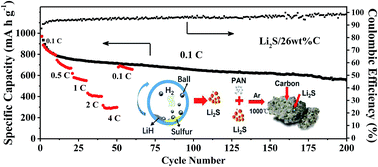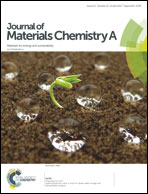A mechanochemical synthesis of submicron-sized Li2S and a mesoporous Li2S/C hybrid for high performance lithium/sulfur battery cathodes†
Abstract
Lithium sulfide, Li2S, is a promising cathode material for lithium–sulfur batteries (LSBs), with a high theoretical capacity of 1166 mA h g−1. However, it suffers from low cycling stability, low-rate capability and high initial activation potential. In addition, commercially available Li2S is of high cost and of large size, over ten microns, which further exacerbate its shortcomings as a sulfur cathode. Exploring new approaches to fabricate small-sized Li2S of low cost and to achieve Li2S cathodes of high electrochemical performance is highly desired. This work reports a novel mechanochemical method for synthesizing Li2S of high purity and submicron size by ball-milling LiH with sulfur in an Ar atmosphere at room temperature. By further milling the as-synthesized Li2S with polyacrylonitrile (PAN) followed by carbonization of PAN at 1000 °C, a Li2S/C hybrid with nano-sized Li2S embedded in a mesoporous carbon matrix is achieved. The hybrid with Li2S as high as 74 wt% shows a high initial capacity of 971 mA h g−1 at 0.1C and retains a capacity of 570 mA h g−1 after 200 cycles as a cathode material for LSBs. A capacity of 610 mA h g−1 is obtained at 1C. The synthesis method of Li2S is facile, environmentally benign, and of high output and low cost. The present work opens a new route for the scalable fabrication of submicron-sized Li2S and for the development of high performance Li2S-based cathodes.



 Please wait while we load your content...
Please wait while we load your content...